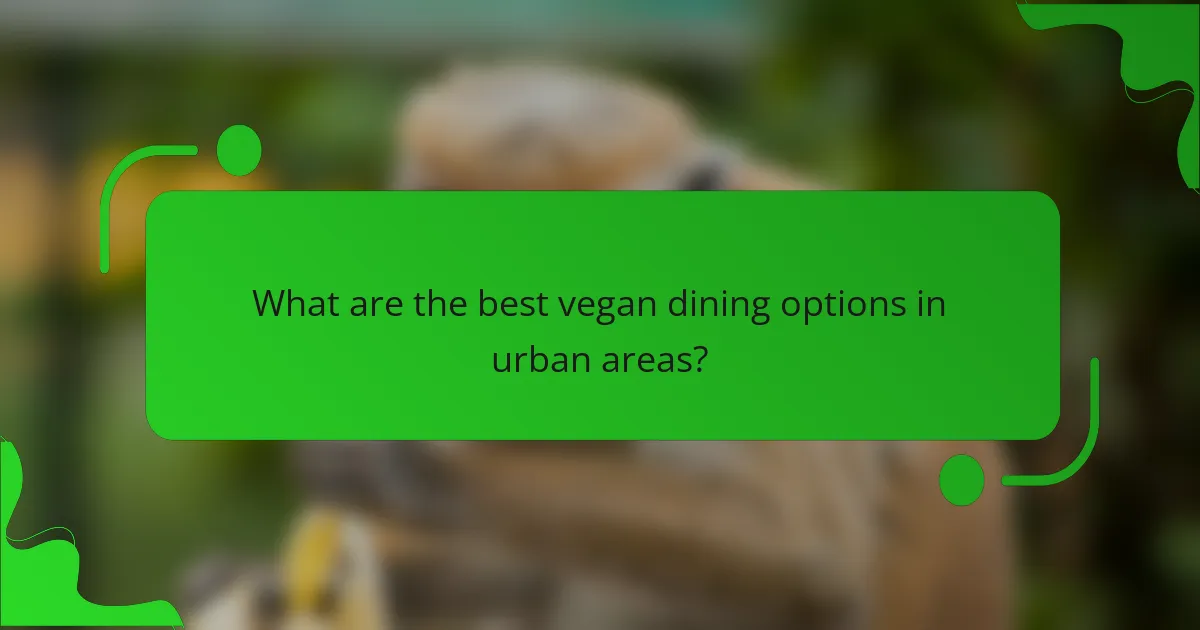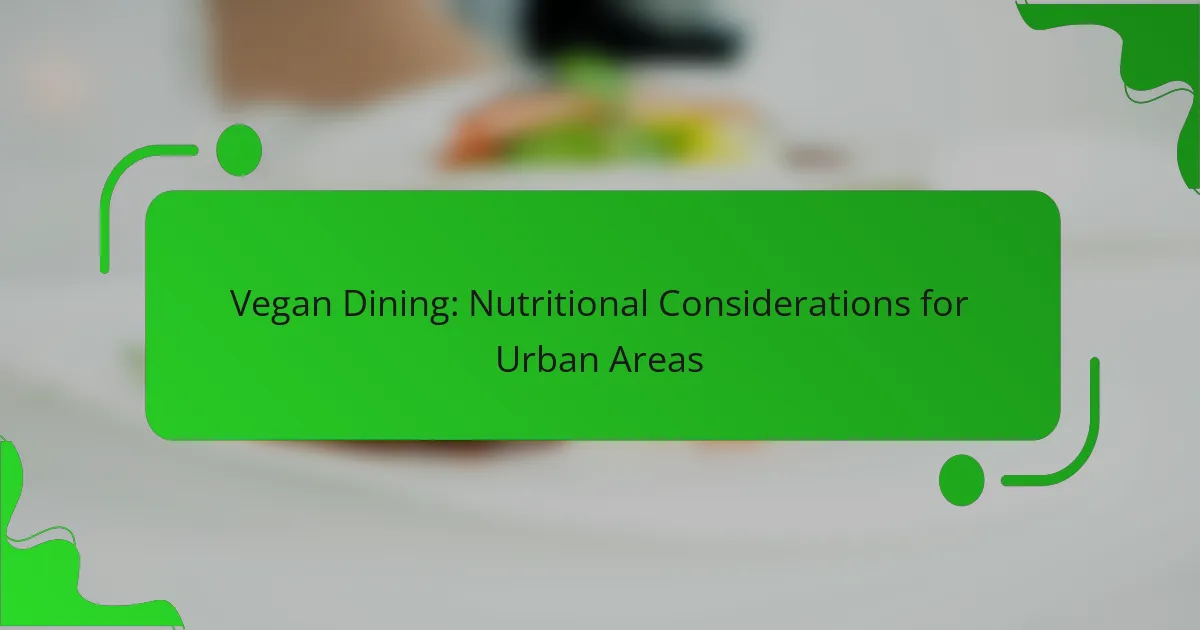Vegan dining in urban areas offers a rich tapestry of plant-based restaurants, food trucks, and cafes that cater to a wide range of tastes and budgets. While enjoying these diverse options, it’s essential to focus on incorporating a variety of nutrient-dense foods like legumes, whole grains, and fresh produce to ensure a balanced diet amidst the challenges of city living.

What are the best vegan dining options in urban areas?
The best vegan dining options in urban areas include a variety of plant-based restaurants, food trucks, and cafes that cater to diverse tastes and budgets. These establishments often emphasize fresh ingredients, innovative dishes, and local sourcing, making it easier for vegans to find satisfying meals.
Plant-based restaurants in Los Angeles
Los Angeles is home to numerous plant-based restaurants that offer a wide range of vegan dishes. Popular spots like Crossroads Kitchen and Gracias Madre serve upscale, gourmet meals, while places like Veggie Grill provide casual dining options. Many of these restaurants focus on organic ingredients and sustainability.
When dining out in Los Angeles, consider trying seasonal specials or chef’s recommendations to experience the freshest flavors. Reservations are often recommended for popular venues, especially during weekends.
Vegan food trucks in New York City
New York City boasts a vibrant scene of vegan food trucks, offering quick and delicious meals on the go. Trucks like The Cinnamon Snail and Veganized serve everything from hearty sandwiches to sweet treats. These mobile eateries often rotate locations, so checking their social media for schedules is essential.
To make the most of your food truck experience, explore different neighborhoods to discover unique offerings. Be prepared for lines, especially during lunchtime, as food trucks can attract large crowds.
Local vegan cafes in Chicago
Chicago’s local vegan cafes provide a cozy atmosphere for enjoying plant-based meals and beverages. Cafes like Althea and The Chicago Diner are known for their inviting menus, featuring everything from breakfast items to desserts. Many cafes also offer gluten-free options to accommodate various dietary needs.
When visiting these cafes, consider trying their signature drinks or daily specials for a unique taste of local flavors. Many cafes also prioritize community engagement, often hosting events or workshops related to veganism and sustainability.

How can I ensure balanced nutrition while dining vegan?
To ensure balanced nutrition while dining vegan, focus on incorporating a variety of plant-based foods that provide essential nutrients. This includes legumes, whole grains, nuts, seeds, fruits, and vegetables to meet your dietary needs.
Essential nutrients for vegans
Vegans need to pay special attention to certain nutrients that are commonly found in animal products. Key nutrients include vitamin B12, iron, calcium, omega-3 fatty acids, and vitamin D. These nutrients can be obtained through fortified foods, supplements, or specific plant sources.
For example, vitamin B12 is crucial for nerve function and can be found in fortified plant milks and nutritional yeast. Iron can be sourced from lentils, chickpeas, and quinoa, while calcium is abundant in leafy greens and fortified tofu.
Protein sources in vegan diets
Protein is vital for muscle repair and overall health, and vegans can obtain it from various plant-based sources. Legumes, such as beans and lentils, are excellent protein sources, as are whole grains like quinoa and brown rice.
Nuts and seeds, including almonds, chia seeds, and hemp seeds, also provide significant protein. Combining different protein sources throughout the day can help ensure you meet your protein needs effectively.

What are the challenges of vegan dining in cities?
Vegan dining in urban areas often faces challenges such as limited food options and higher ingredient costs. These factors can make it difficult for individuals to maintain a balanced vegan diet while navigating the complexities of city living.
Limited options in certain neighborhoods
In many urban neighborhoods, especially those with fewer grocery stores or restaurants, the availability of vegan options can be quite limited. This scarcity can lead to reliance on processed foods or less nutritious choices, which may not meet dietary needs.
To address this, consider exploring local farmers’ markets or specialty stores that may offer a wider range of fresh produce and vegan products. Online delivery services can also provide access to a greater variety of vegan ingredients, even in areas with limited local options.
Higher costs of vegan ingredients
The cost of vegan ingredients can be significantly higher in urban areas compared to non-vegan options. Specialty items like plant-based proteins, organic produce, and vegan dairy alternatives often come with a premium price tag, which can strain budgets.
To manage expenses, focus on buying seasonal produce and bulk items, which can reduce costs. Planning meals around affordable staples like beans, lentils, and grains can also help maintain a nutritious diet without overspending.

How do I find vegan-friendly restaurants nearby?
To find vegan-friendly restaurants nearby, you can use various online resources and apps that specialize in plant-based dining options. These tools allow you to search based on your location, dietary preferences, and user reviews, making it easier to discover suitable eateries.
Using apps like HappyCow
HappyCow is a popular app that helps users locate vegan and vegetarian restaurants in their vicinity. By entering your location, you can access a list of nearby options along with detailed information such as menus, hours, and user ratings.
When using HappyCow, consider filtering your search by distance or cuisine type to find the best match for your preferences. The app often includes user-submitted photos and reviews, which can provide insight into the dining experience.
Online reviews and local guides
Online reviews on platforms like Yelp or Google Maps can be invaluable for finding vegan-friendly restaurants. Look for establishments with high ratings and read through comments to gauge the quality of vegan options available.
Local food blogs and guides can also highlight hidden gems in your area. Many cities have dedicated vegan or plant-based dining guides that curate lists of the best spots, often including personal recommendations and tips for what to order.

What are the environmental benefits of vegan dining?
Vegan dining offers significant environmental benefits, primarily by reducing greenhouse gas emissions and conserving natural resources. By choosing plant-based foods, individuals can contribute to a more sustainable food system that minimizes ecological impact.
Reduced carbon footprint
Adopting a vegan diet can lead to a lower carbon footprint compared to meat-based diets. Animal agriculture is a major contributor to greenhouse gas emissions, accounting for a substantial portion of global emissions. By shifting to plant-based foods, individuals can significantly decrease their personal carbon output.
For example, studies suggest that a vegan diet can reduce an individual’s carbon emissions by approximately 50% or more compared to a typical omnivorous diet. This reduction is largely due to the lower energy requirements for producing plant foods versus animal products.
Lower water usage in plant-based diets
Plant-based diets generally require less water than diets that include meat and dairy. Producing animal products is water-intensive, with livestock farming consuming vast amounts of water for feed, drinking, and processing. In contrast, crops like grains, legumes, and vegetables use significantly less water per calorie produced.
On average, producing one kilogram of beef can require over 15,000 liters of water, whereas producing one kilogram of vegetables may only need around 300 to 500 liters. This stark difference highlights the water conservation potential of vegan dining.

How can urban areas improve vegan dining accessibility?
Urban areas can enhance vegan dining accessibility by increasing the availability of plant-based options and supporting local initiatives. This can involve promoting restaurants that offer vegan meals, creating community gardens, and facilitating partnerships between local farmers and eateries.
Community initiatives for local sourcing
Community initiatives can play a crucial role in improving vegan dining by connecting local farmers with restaurants and consumers. Urban farms and community gardens can provide fresh produce, making it easier for eateries to source ingredients sustainably and locally.
Programs that encourage farmers’ markets can also help by allowing urban residents to access fresh, organic vegetables and fruits. These markets often feature vendors who specialize in vegan products, thus increasing the variety available to consumers.
Government support for vegan businesses
Government support can significantly impact the growth of vegan dining options in urban areas. This can include providing grants or subsidies to vegan restaurants, which can help offset initial costs and encourage new businesses to open.
Additionally, local governments can implement policies that promote plant-based diets, such as tax incentives for businesses that prioritize vegan offerings or educational campaigns that highlight the benefits of veganism for health and the environment.

What are the emerging trends in vegan dining?
Emerging trends in vegan dining reflect a growing interest in plant-based foods, sustainability, and health. Urban areas are seeing an increase in innovative vegan restaurants, food trucks, and grocery options that cater to diverse tastes and dietary needs.
Plant-based meat alternatives
Plant-based meat alternatives are becoming increasingly popular, offering consumers a way to enjoy familiar flavors and textures without animal products. Brands like Beyond Meat and Impossible Foods have led the charge, creating products that mimic the taste of beef, chicken, and pork.
These alternatives often use ingredients like pea protein, soy, and various spices to achieve their flavor profiles. As more people seek to reduce their meat consumption, these products provide a convenient option for transitioning to a vegan diet.
Local sourcing and seasonal menus
Many vegan restaurants are focusing on local sourcing and seasonal menus, emphasizing fresh ingredients that support local farmers. This trend not only enhances the flavor of dishes but also reduces the carbon footprint associated with transporting food over long distances.
Urban diners can expect to find menus that change with the seasons, featuring ingredients that are at their peak freshness. This approach encourages creativity in the kitchen and promotes a deeper connection to the food being consumed.
Health-focused vegan options
Health-focused vegan options are gaining traction, with many diners looking for meals that are not only plant-based but also nutrient-dense. Restaurants are increasingly offering dishes that highlight whole foods, such as grains, legumes, and a variety of vegetables.
Options like quinoa bowls, smoothie bowls, and salads packed with superfoods cater to health-conscious consumers. This trend encourages a balanced approach to vegan dining, ensuring that meals are both satisfying and nourishing.
Vegan meal delivery services
Vegan meal delivery services are on the rise, providing convenient options for busy urban dwellers. These services offer pre-prepared meals or meal kits that make it easy to enjoy plant-based dining at home.
Many of these services focus on organic, non-GMO ingredients and cater to various dietary preferences, including gluten-free and low-carb options. This trend supports the growing demand for accessible vegan meals without the need for extensive cooking skills.



